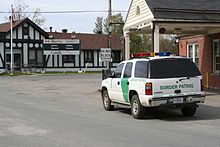
Orleans County is a county located in the northeastern part of the U.S. state of Vermont. As of the 2020 census, the population was 27,393. Its shire town is the city of Newport. The county was created in 1792 and organized in 1799. As in the rest of New England, few governmental powers have been granted to the county. The county is an expedient way of grouping and distributing state-controlled governmental services.

Franklin County is a county located in the U.S. state of Vermont. As of the 2020 census, the population was 49,946. Its county seat is the city of St. Albans. It borders the Canadian province of Quebec. The county was created in 1792 and organized in 1796. Franklin County is part of the Burlington metropolitan area.

Pittsburg is a town in Coös County, New Hampshire, United States. The population was 800 at the 2020 census. It is the northernmost town in New Hampshire and the largest town by area in New England. U.S. Route 3 is the only major highway in the town, although the northern terminus of New Hampshire Route 145 also lies within Pittsburg.

Lyndonville is a village in the town of Lyndon, in Caledonia County, Vermont, United States. Lyndonville's population was 1,136 at the 2020 census. It is the closest community to the Lyndon campus of Northern Vermont University.

Brighton is a town in Essex County, Vermont, United States. The population was 1,157 at the 2020 census. The town was named "Gilead" in its original grant in 1780. The town was sold to a group consisting primarily of soldiers commanded by Colonel Joseph Nightingale and subsequently named "Random". The town's name was finally changed by the legislature to "Brighton" in 1832. The Brighton village of Island Pond gets its name from the Abenaki word Menanbawk, which literally means island pond.

Canaan is a town in Essex County, Vermont, United States. The population was 896 at the 2020 census. Canaan contains the village of Beecher Falls, located at the confluence of the Connecticut River and Halls Stream. It is part of the Berlin, NH-VT Micropolitan Statistical Area.

Norton is a town in Essex County, Vermont, United States. The population was 153 at the 2020 census. It is part of the Berlin, NH –VT Micropolitan Statistical Area. It is located on the Canada–US border, immediately south of Stanhope, Quebec.

Highgate is a town in Franklin County, Vermont, United States. The population was 3,472 at the 2020 census. The town is on the Canada–US border and is a border town with Philipsburg, Quebec.

Richford is a town in Franklin County, Vermont, United States, located along the Canada–United States border. The population was 2,346 at the 2020 census.

Derby is a town in Orleans County, Vermont, United States. The population was 4,579 at the 2020 census, making it the most populous community in Orleans County. The town contains four unincorporated villages: Beebe Plain, Clyde Pond, Lake Salem, and North Derby, and two incorporated villages: Derby Center and Derby Line.

Stanstead is a town in the Memphrémagog Regional County Municipality in the Estrie region of Quebec, located on the Canada–United States border across from Derby Line, Vermont.

The Haskell Free Library and Opera House is a Victorian building that straddles the Canada–United States border, in Rock Island, Quebec, and Derby Line, Vermont, respectively. The Opera House opened on June 7, 1904, having deliberately been built on the international border. It was declared a heritage building by both countries in the 1970s and 1980s.

Alburgh is a town in Grand Isle County, Vermont, United States, founded in 1781 by Ira Allen. The population was 2,106 at the 2020 United States Census. Alburgh is on the Alburgh Tongue, a peninsula extending from Canada into Lake Champlain, and lies on the only road-based route across Lake Champlain to New York state north of Addison, Vermont.
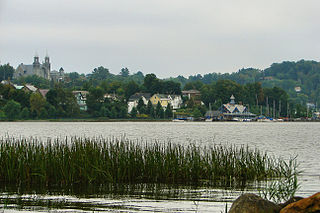
Newport is the only city in, and the shire town of, Orleans County, Vermont, United States. As of the 2020 Census, the population was 4,455. The city contains the second-largest population of any municipality in the county, and has the smallest geographic area. It is the second-smallest city by population in Vermont. Newport is also the name of neighboring Newport Town.

Beebe Plain is an unincorporated community in the town of Derby in Orleans County, Vermont, United States, which extends into the municipality of Stanstead, Quebec, Canada. The village is divided by the Canada–United States border between Canada and the United States; the Canadian portion of Beebe Plain had the status of an incorporated municipality in its own right until 1995.
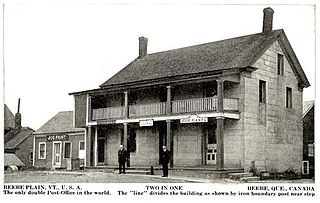
Beebe Plain is an unincorporated geographically-contiguous settlement, split politically between Canada and the United States. An unincorporated village partially in Stanstead and partially in Derby Line, it is divided by the Quebec-Vermont border. This settlement was begun by David and Calvin Beebe in 1798.
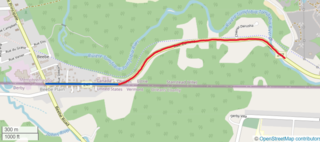
Canusa Street is a road part of Quebec Route 247.
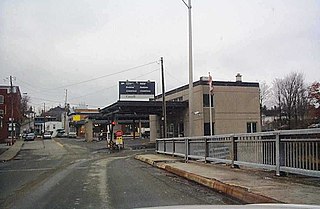
The Derby Line–Stanstead Border Crossing is a border crossing station on the Canada–United States border, connecting the towns of Stanstead, Quebec and Derby Line, Vermont. It connects Main Street in Derby Line with Quebec Route 143 in Stanstead. It is one of two local crossings between the two towns, which historically had many more. This was a major crossing point until the construction of Interstate 91 (I-91) and the Derby Line–Rock Island Border Crossing in 1965. The historic 1930s United States station facilities were listed on the National Register of Historic Places in 2014. Both stations are open 24 hours per day.
The Massawippi Valley Railway was a short line railway established in 1870 between Lennoxville, Quebec, and the Vermont border. Part of the Quebec Central Railway from 1926, the line was abandoned in 1990 and removed in 1992. Most of the former railway's right of way is now used for bicycle trails.

A line house is a building deliberately located so that an international boundary passes through it. One such building on the boundary between the United States and Canada is the Haskell Free Library and Opera House in Stanstead, Quebec, and Derby Line, Vermont. The border is marked on the floor in a reading room and an auditorium. A number of single-family residences and some industrial buildings straddle the boundary in those two towns.

